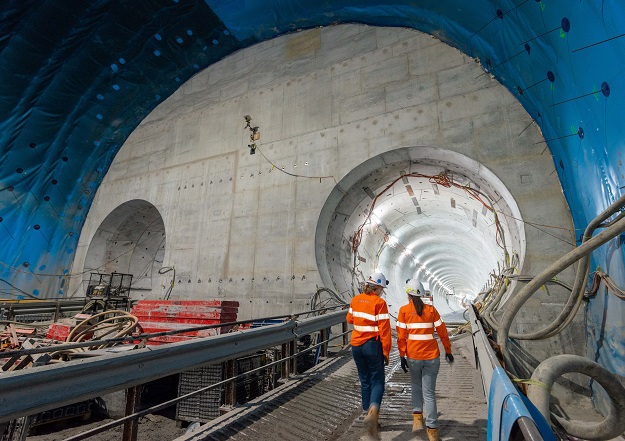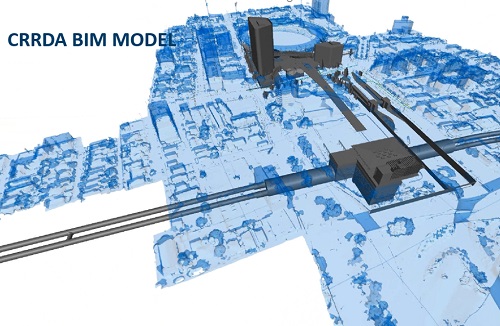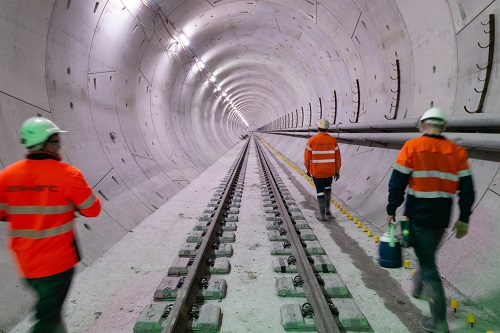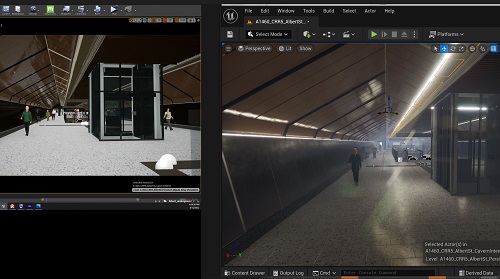
Brisbane’s Cross River Rail project includes building 5.9 km of twin tunnels plus four huge caverns, such as this one at Roma St. All images courtesy Cross River Rail.
CRR’s 3D digital modelling is continuing to produce transformative new practical applications.
By Russell Vine
As Brisbane’s transformational Cross River Rail project enters its fourth year of construction and with the first station buildings beginning to appear out of the ground, new practical uses of the project’s ground-breaking digital model are also revealing themselves on almost a monthly basis.
One of Australia’s largest rail infrastructure initiatives, Cross River Rail is 10.2 km of new rail line, including 5.9 km of twin tunnels that run under the Brisbane River and CBD. At its core there will be four new inner-city underground stations at Boggo Road, Woolloongabba, Albert Street and Roma Street (see Position 113, Jun/Jul 2021, p.34: https://bit.ly/3Udhf1g).
The project is also delivering two new above-ground stations at Exhibition and Dutton Park; six rebuilt stations between Fairfield and Salisbury to the south of the city; three new stations on the Gold Coast; reconfiguration for two new train stabling facilities and installation of a new world-class signalling system.
It is a big project being built by a team determined to transform the way people travel across the whole of South East Queensland, and that same team is equally determined to seize the project as an innovation opportunity across all aspects of construction, including digital modelling.
That is why going back as far as 2018 — before major contractors had even been appointed — the team at Cross River Rail mapped out a strategy for the roles of GIS land mapping, BIM modelling and the use of virtual reality and gaming engines, to ensure best possible outcomes during construction.
That strategy is referred to as the project’s Digital Network Approach, or ‘Project DNA,’ which to date has included contractual obligations to ensure construction companies feed data to a single federated BIM model, enabling the development of a bespoke GIS web map complete with a capability to shift from 2D to 3D LiDAR/photogrammetry, and the feeding of all digital datasets into a Common Data Environment (CDE).

A snapshot of the Project DNA (Digital Network Approach) single federated BIM model, into which construction companies feed data.
This CDE has been used to build an interactive, virtual version of Cross River Rail using Unreal Engine, one of the world’s most open and advanced real-time 3D creation tools, used for development of photoreal visuals and interactive, immersive experiences. The result has been the creation of a navigable digital twin of the Brisbane CBD, complete with new underground stations and twin underground tunnels, enabling users to ‘travel’ anywhere along the new, yet-to-be-completed rail line.
But the team did not stop at the development of a full, interactive virtual Cross River Rail. Fast forward to 2022 — with the project’s twin tunnels now excavated and lined, all four underground station caverns fully excavated and the project moving into new phases of station construction, rail installation and tunnel fit out — and the delivery team’s uses of Project DNA are moving forward also.
From ‘not built’ to ‘as-built’
With tunnel excavation and lining completed in December 2021, the twin tunnels linking Cross River Rail’s four new underground stations are the first sections of the project’s digital model to become truly ‘as-built’ and reflective of real-world infrastructure.
Even more remarkable is that the tunnels in the digital model are not only true to the path of the real tunnels, but were corrected and updated to within 10mm accuracy by using real time telemetry feeds from ‘Merle’ and ‘Else,’ the two giant tunnel boring machines (TBMs) that completed the majority of the excavation.
Equally impressive is the fact that data was also relayed from the TBMs, enabling Cross River Rail to update the digital model with the size and specification, as well as an individual barcode, for each of the 24,000 individual concrete segments used to line twin tunnels.
Not every segment in the tunnels is identical, with different tunnel sections having different complexities when it comes to the lining structure. Having the digital twin tunnels lined with 24,000 digital assets true to the 24,000 segments in the real tunnels has not only reduced risk during installation, but opened the door for the development of an ongoing sophisticated digital asset-based tunnel operation, management and maintenance systems.

24,000 individual concrete segments, not all of which are identical, are used to line twin tunnels.
Increased use of augmented reality
With a federated BIM model now made up of over 14 million separate digital assets — and having used Unreal Engine to build a virtual version of the project that allows teams to ‘walk’ first-person through future construction outcomes — exploring uses for augmented reality (AR) has become a new frontier for the delivery team.
In particular, AR is being used during construction of the project’s Exhibition station to the north of Brisbane CBD, as well as at Mayne Yard, where a new stabling yard has been built. In both instances, contractor consortium Unity has developed applications that enable engineers to view BIM model data in real time and as an AR overlay, when looking at worksites using a phone or tablet camera.
Data sets pulled through and viewable also include subsurface utilities such as water, electrical and sewer paths, enabling workers to not only superimpose future structures over existing worksites, but also essentially ‘x-ray’ ground planes before the start of piling or excavation.
‘Architect grade-levels’ of visual detail
One of the greatest benefits of Project DNA has been the ability to tour future underground stations in first-person and within an interactive virtual reality.
Not only has this enabled the project team to share with the public what the final stations will look and feel like, it has also provided engineers and designers an opportunity to troubleshoot built environments yet to be constructed, and, in some cases, identify and make critical design refinements that might not otherwise have been picked up.
As the stages of station fit-out draw closer however, Cross River Rail has continued to explore ways of updating the visual fidelity of these VR environments so that finer aspects of finishes, materials and lighting can be examined in much more detail. This also enables the look and feel of future stations to be rigorously tested well in advance of construction.
In these upgraded environments, the level of detail on flooring and wall finishes is accurate down to two millimetres, and all aspects of lighting and shadows become much more photo-realistic.
Beyond finishes and materials
The station environments can also now be animated to include moving passengers, trains that come and go at platform level and animated content running on areas such as LED advertising screens or dynamic and digital signage boards.
This enables the higher-fidelity, increased-level-of-detail visual environment to also be used to review and refine wider aspects of the future stations as a public transport user experience.
In the digital twin of the project’s new Roma Street station ground level, teams are using the model to experiment with the possible installation and addition of a giant art space proposed for the far wall of the concourse.
This huge 40-by-18-metre expanse will be one of the largest public art installations in a train station anywhere in the world, so the ability to contemplate the art as a visual outcome in a fully immersive, first-person virtual reality is of significant benefit to all parties involved.

Side-by-side comparison showing the boost in visual fidelity of the Project DNA ‘VIS’ model by moving from Unreal Engine version 4 to version 5.
Similarly, having a detailed digital twin of each station built in a flexible gaming engine is also giving the project’s design teams the opportunity to not only review the location of things such as signage, wayfinding and advertising screens, but to also contemplate how the finer points of the infrastructure will operate, and explore possibilities of them being powered in part by the digital twin of each station, which will of course be on hand on day one of operation.
An example of this, in relation to wayfinding, is the idea of information totems or ‘responsive signage’ points, where train station patrons could use an interactive information point to provide a 3D model of the station and its surrounds (most likely to their phone), to assist with journey planning.
Beyond construction
The majority of construction on Cross River Rail is expected to be mostly complete within 2024. It is hoped that despite the hurdles of COVID, global economic pressures and Queensland’s tendency to experience severe weather events, the first services will be successfully tested on the rail line within 2025.
That gives the project two to three more years to not only continue finding practical uses of its digital modelling for the completion of construction, testing and commissioning, but also to consider what the role of a leading-edge digital model will be in the operation and maintenance of the new rail line.
And while what Cross River Rail has built so far in the digital space can certainly be described as a ‘digital twin,’ the project team is quick to point out that technically, only one of the twins exists so far, as much of the real-world version of the project is yet to move through multiple phases of construction.
So the journey for Cross River Rail from now until the end of 2024 will involve continuing to refine and update the accuracy of a digital model as it moves from being indicative of something that is being built, to being detailed and identical in every way to a piece of rail infrastructure that has been built.
And while the opportunities to plan and execute what the role of the digital model will be in maintaining the infrastructure are very real, it is the chance to also explore how the digital twin could transform how a rail line operates and be a catalyst for truly futuristic, tech-enabled rail experiences that the project team prizes most highly. Not least of all when you consider that beyond 2025 and the opening of Cross River Rail, Brisbane also has another interesting milestone on its horizon in 2032, when the city will host the Olympic and Paralympic Games.
Russell Vine is Lead Innovation Officer with the Cross River Rail Delivery Authority and a member of the Delivery Authority’s Executive Leadership Team. This article is an update on progress with the CRR; you can read Russell’s earlier coverage from 2021 at https://bit.ly/3QURgJe.
This article was first published in the Oct/Nov 2022 issue of Position magazine.
Stay up to date by getting stories like this delivered to your inbox.
Sign up to receive our free weekly Spatial Source newsletter.







